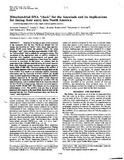Mostrar el registro sencillo del ítem
Mitochondrial DNA “clock” for the Amerinds and its implications for timing their entry into North America
| dc.creator | Torroni, Antonio | |
| dc.creator | Neel, James V. | |
| dc.creator | Barrantes Mesén, Ramiro | |
| dc.creator | Schurr, Theodore G. | |
| dc.creator | Wallace, Douglas | |
| dc.date.accessioned | 2015-08-03T19:48:47Z | |
| dc.date.available | 2015-08-03T19:48:47Z | |
| dc.date.issued | 1994-02 | |
| dc.identifier.citation | http://www.pnas.org/content/91/3/1158.abstract | |
| dc.identifier.issn | 1091-6490 | |
| dc.identifier.uri | https://hdl.handle.net/10669/15164 | |
| dc.description | Artículo científico -- Universidad de Costa Rica, Instituto de Investigaciones en Salud. 1994 | es_ES |
| dc.description.abstract | Students of the time of entry of the ancestors of the Amerinds into the New World are divided into two camps, one favoring an "early" entry [more than approximately 30,000 years before the present (YBP)], the other favoring a "late" entry (less than approximately 13,000 YBP). An "intermediate" date is unlikely for geological reasons. The correlation of the appropriate data on mtDNA variation in Amerinds with linguistic, archaeological, and genetic data offers the possibility of establishing a time frame for mtDNA evolution in Amerinds. In this paper, we estimate that the separation of the Chibcha-speaking tribes of Central America from other linguistic groups/nascent tribes began approximately 8000-10,000 YBP. Characterization of the mtDNA of 110 Chibcha speakers with 14 restriction enzymes leads on the basis of their time depth to an estimated mtDNA nucleotide substitution rate for Amerinds of 0.022-0.029% per 10,000 years. As a first application of this rate, we consider the mtDNA variation observed in 18 Amerind tribes widely dispersed throughout the Americas and studied by ourselves with the same techniques, and we estimate that if the Amerinds entered the New World as a single group, that entry occurred approximately 22,000-29,000 YBP. This estimate carries a large but indeterminate error. The mtDNA data are thus at present equivocal with respect to the most likely times of entry of the Amerind into the New World mentioned above but favor the "early" entry hypothesis. | es_ES |
| dc.description.sponsorship | Universidad de Costa Rica, Instituto de Investigaciones en Salud | es_ES |
| dc.language.iso | en_US | es_ES |
| dc.source | Proceedings of the National Academy of Sciences of the United States of América 91(3):1158-1162 | es_ES |
| dc.subject | Mitochondrial DNA | es_ES |
| dc.subject | Chibcha time depth | es_ES |
| dc.subject | amerinds | es_ES |
| dc.subject | variation in mitochondrial DNA | es_ES |
| dc.subject | amerind tribes | es_ES |
| dc.subject | Human genetics | es_ES |
| dc.subject | Población indígena | es_ES |
| dc.title | Mitochondrial DNA “clock” for the Amerinds and its implications for timing their entry into North America | es_ES |
| dc.type | artículo original | |
| dc.identifier.doi | doi: 10.1073/pnas.91.3.1158 | |
| dc.description.procedence | UCR::Vicerrectoría de Investigación::Unidades de Investigación::Ciencias de la Salud::Instituto de Investigaciones en Salud (INISA) | es_ES |


